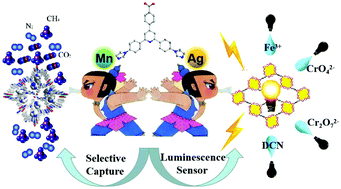Two novel metal–organic frameworks based on pyridyl-imidazole-carboxyl multifunctional ligand: selective CO2 capture and multiresponsive luminescence sensor†
Abstract
Two novel metal–organic frameworks, formulated as [Mn(CIP−)2] (1) and [Ag(CIP−)] (2) (HCIP = 4-(4-carboxylphenyl)-2,6-di(4-imidazol-1-yl)phenyl)pyridine), were solvothermally synthesized based on a pyridyl-imidazole-carboxyl multifunctional ligand. The single-crystal X-ray diffraction analysis shows that complex 1 is a 3D microporous framework with uncoordinated imidazole groups, and complex 2 is a 2D + 2D → 2D 3-fold parallel interpenetrated network. Complex 1 exhibited excellent CO2 selective absorption over N2 and CH4. IAST calculations revealed that the selectivities of 1 for the CO2/CH4 (50 : 50) and CO2/N2 (15 : 85) mixtures were 8.0 and 117 at 273 K under 1 bar, respectively. Moreover, the luminescence investigations displayed that complex 2 is an excellent MOF-based multiresponsive fluorescent probe for Fe3+, CrO42−/Cr2O72− and the pesticide 2,6-Dich-4-nitroaniline, with high selectivity and sensitivity. Notably, complex 2 exhibited a highly sensitive sensing ability (5.2 × 104 M−1) and a low detection limit (1.7 × 10−7 M) for 2,6-Dich-4-nitroaniline. To the best of our knowledge, this is the first Ag-MOF-based fluorescent sensor that can simultaneously detect metal ions, inorganic anions and pesticides.



 Please wait while we load your content...
Please wait while we load your content...